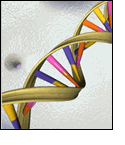Return to Online
Education Kit
|
 |
 |
 Previous Event | Next Event Previous Event | Next Event 
2000: Fly Model of Parkinson's Disease Reported

Researchers working at Harvard Medical School have used gene splicing techniques to produce Drosophila (fruit flies) that display many of the symptoms of Parkinson’s disease. Several years ago other researchers first noticed dense complexes of proteins surrounded by a halo-like ring in neurons located deep within the brains of people with Parkinson’s disease. It is not known if these complexes, called Lewy bodies, cause the death of neurons or perhaps are part of the body’s protective response to the disease. The main protein in Lewy bodies is called alpha-synuclein. In their report, the researchers describe inserting both normal and mutated forms of the alpha-synuclein gene into Drosophila. Flies with the mutant gene not only displayed Lewy bodies in their brains but they also exhibited other symptoms of the disease such as problems with movement. The fly model of Parkinson’s disease is important because of Drosophila’s short life cycle. Researchers can use it to quickly test their ideas about the role of Lewy bodies and to assess the effectiveness of drugs and other approaches to treat the disease.
More Information
Reference:
Feany, M.B., Bender, W.W. A Drosophila model of Parkinson’s disease. Nature, 404:394-398. 2000.
 Previous Event | Next Event Previous Event | Next Event 
Last Reviewed: April 10, 2008
|

